License Proprietary Classification Transitional Date created 2004 | Foundry Microsoft Typography | |
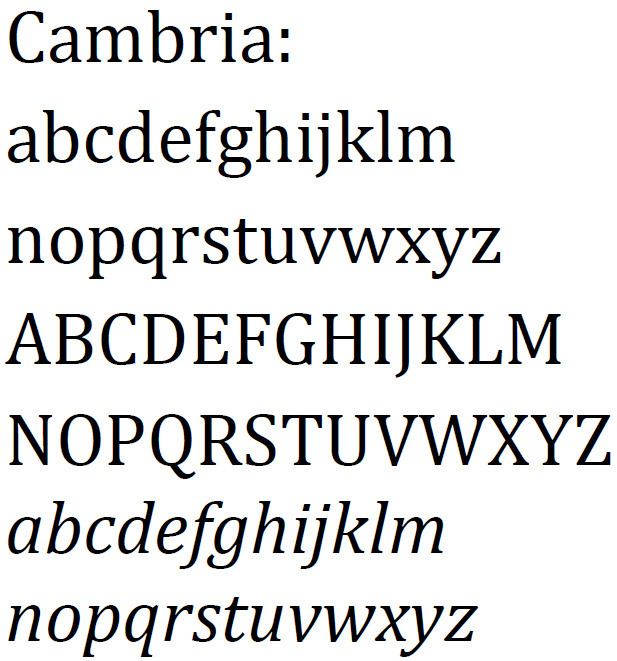 | ||
Link microsoft.com/typography/fonts/family.aspx Designer Steve Matteson, Robin Nicholas, Jelle Bosma | ||
Cambria typeface
Cambria is a transitional serif typeface commissioned by Microsoft and distributed with Windows and Office. It was designed by Dutch typeface designer Jelle Bosma in 2004, with input from Steve Matteson and Robin Nicholas. It is intended as a serif font that is suitable for body text, that is very readable printed small or displayed on a low-resolution screen and has even spacing and proportions.
Contents
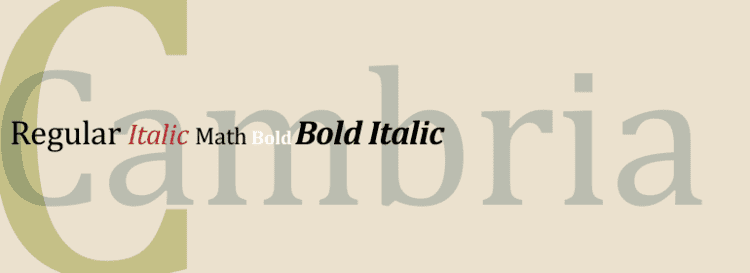
It is part of the ClearType Font Collection, a suite of fonts from various designers released with Windows Vista. All start with the letter C to reflect that they were designed to work well with Microsoft's ClearType text rendering system, a text rendering engine designed to make text clearer to read on LCD monitors. The other fonts in the same group are Calibri, Candara, Consolas, Constantia and Corbel.

An unrelated font using the Cambria name was created by type designer Ian Koshnick in 1989 for his software publishing company, Cambria Publishing.
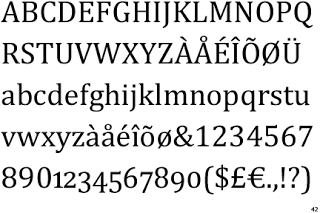
Design
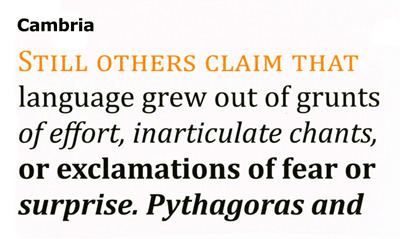
Diagonal and vertical hairlines and serifs are relatively strong, while horizontal serifs are small and intend to emphasize stroke endings rather than stand out themselves. This principle is most noticeable in the italics where the lowercase characters are subdued in style. It is somewhat more condensed than average for a font of its kind. A profile of Bosma for the Monotype website commented: "One of the defining features of the typeface is its contrast between heavy vertical serifs and hairlines – which keep the font sturdy, and ensures the design is preserved at small sizes – and its relatively thin horizontals, which ensure the typeface remains crisp when used at larger sizes."
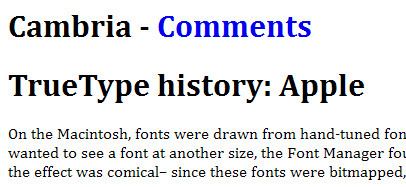
Many aspects of the design are somewhat blocky to render well on screen, and full stops are square rather than round. Designers have recommended avoiding using it in printed text because of this: designer Matthew Butterick described it as too monotonous to be attractive on paper. Bosna compared it to optical sizes of fonts designed to be printed small: "The design is a bit like an old metal type font. In those days sizes had their own drawing, so that small sizes are wider and have a lower contrast compared to large fonts in the same design: optical correction. In this sense, Cambria is like a small size font, except that it may also be used at large sizes."
As with the other ClearType fonts, both lining figures and text figures are offered. Lining figures are the default, and are shown on the sample image.
Cambria Math
This is a variant designed for mathematical and scientific texts, as a replacement for Times New Roman. Cambria Math was the first font to implement the OpenType math extension, itself inspired from TeX. Led by Jelle Bosma of Agfa Monotype and Ross Mills of Tiro Typeworks, the project was planned when development of Cambria had started, but Cambria Math was developed in three stages.
Availability
Cambria is distributed with Windows Vista, Windows 7, Microsoft Office 2007, Microsoft Office 2008 and 2011 for Mac, and Microsoft Office 2007 viewers and converters. Cambria (Regular) and Cambria Math are packaged together as a TrueType Collection (TTC) file. Microsoft Office 2008 for Mac does not include Cambria Math, as OMML is not supported. Therefore, the Macintosh version of Cambria is packaged as individual TrueType Font (TTF) files, rather than a single TTC file.
This font, along with Calibri, Candara, Consolas, Corbel and Constantia, is also distributed with Microsoft Excel Viewer, Microsoft PowerPoint Viewer, the Microsoft Office Compatibility Pack for Microsoft Windows and the Open XML File Format Converter for Mac. For use in other operating systems, such as GNU/Linux, cross-platform use and web use it is not available as a freeware.
The typeface is licensed by Ascender Corporation for use by end users and consumer electronics device manufacturers. The typeface is also licensed by Monotype Imaging to printer manufacturers as part of the Vista 8 Font Set package.
Caladea
In 2013, as part of Chrome, Google released a freely-licensed font called Caladea, which is metric-compatible to Cambria (i.e. can replace it in a document without changing the layout). It is based on Cambo, a font developed by the Argentine type foundry Huerta Tipográfica.
Usages
Cambria Math is used for presentation of Office MathML equations in Microsoft Office 2007 and later.
The free typesetting systems XeTeX and LuaTeX can make direct use of Cambria Math as an alternative to traditional TeX mathematical fonts.
Cambria is available for use in Google's Google Drive suite of web applications.
